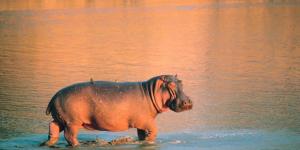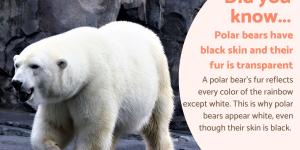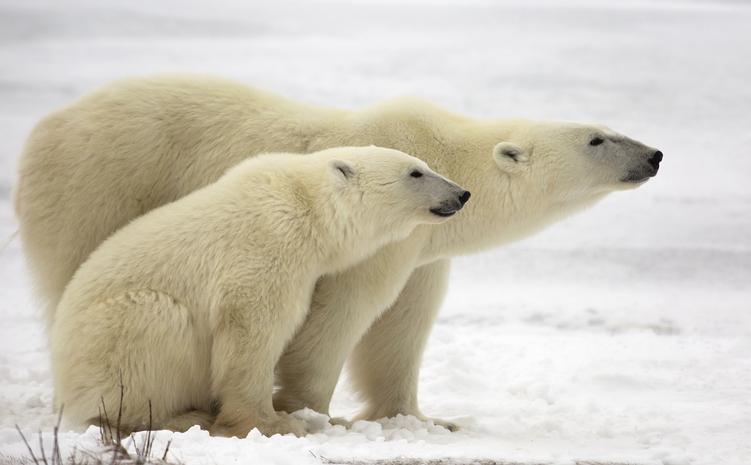How Much Does a Polar Bear Weigh?


The polar bear (Ursus maritimus) are apex predators in their ecosystem and considered to be one of the deadliest carnivores in the world. Not only deadly to their prey animals, polar bears provide a serious risk to humans. This risk has been intensified in recent years thanks to global warming. Bears are driven to forage for food near human settlements due to ice melt reducing the potential prey in their natural habitat. You may have seen some pictures of emaciated polar bear illustrating this problem. They look so thin because they are usually such huge mammals.
This leads AnimalWised to ask how much does a polar bear weigh? These Arctic animals are known for their thick white fur which is used to camouflage against the ice as well as protect them against the freezing temperatures. Even without this fur, the animal is known to be very large.
Physical characteristics of a polar bear
The polar bear's head is longer and narrower than that of its other ursine relatives. This is also seen in their relatively long ears and snout. The truffle (scientifically known as the rhinarium) of their nose is black, as are their eyes and skin. While it might seem strange to have black skin with such white fur, this dark pigmentation allows them to better retain their body heat in their very cold habitats.
Individual hairs also help with insulation. Although they appear white, each strand is hollow and translucent. The white appearance is due to the reflection of light off these translucent strands rather than pigmentation. Their hollowness allows them to be filled with air, also functioning as a form of thermal insulation.
Polar bears generally lose some of their fur during the summer due to molting. Their new coat appears to be a particularly intense white at birth. Especially in spring, their coats may appear more yellowish due to the seasonal sunlight. However, yellowish coloration is more commonly due to oxidization of the follicles, as well as a result of the aging process. This is another reason polar bear cubs may seem more brilliantly white than adults.
The distinctive development of polar bear legs allows them to swim, an action they perform with great skill. Their front legs are slightly curved, with thick and pointed claws. These are ideal both for hunting and moving nimbly across ice floes.
Polar bears have a thick layer of fat that only decreases toward their snouts. Fat accumulation is thanks to their specialized diet. This adipose tissue is essential for these animals to survive in their Arctic ecosystems. Their fat cover decreases during the summer months, as there is less ice during this time. The bear must swim to pursue prey, which requires greater caloric expenditure than if they had done so from the ice floes.
Even though they can swim, they are no match for the graceful seal when it is in the water. This is why seal hunting is mainly carried out during the winter since the polar bear outmatches them on land just as seals do so in water. The relative lack of ice floes in summer means they have less opportunity to pursue seals successfully.
Learn more about how seals move and protect themselves with our article asking do seals have claws on their flippers?
How much does a polar bear cub weigh?
Polar bears sexually mature relatively late, with their reproductive rate being among the lowest of all mammals. Females mature at 4–5 years of age and enter heat between late March and early June. Mating usually occurs in April and May. As with all bears, this species has a form of ovulation known as embryonic diapause. Ovulation is induced after copulation, resulting in delayed implantation in the uterine wall until approximately autumn.
Females stop feeding during gestation and take refuge in burrows they build for this purpose. They must have previously gained considerable weight to have sufficient reserves during this time. Embryonic diapause allows polar bears to wait until environmental conditions are better suited to giving birth, as well as affording them the time to store fat and other food reserves.
Polar bears usually give birth to two cubs, although they can also give birth to individuals or triplets. Polar bears are altricial animals, meaning they rely completely on their mother. They are blind and have very little fur, weighing only around 1.3 lb (600 g). Their mother's milk contains over 30% fat and other nutrients, allowing rapid development of the newborns. They leave the den at about five months of age, weighing around 22-26 lb (10-12 kg). They are able to follow their mother and will remain with her for about two years.
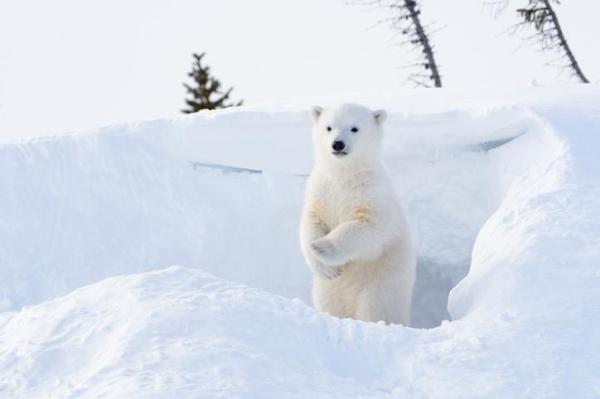
How much does an adult polar bear weigh?
Polar bears are carnivorous animals. Reports indicate that they are the bear species which consumes the largest amount of meat[1]. These ursids process fat in a highly efficient way, even better than proteins. In fact, overconsumption of protein can be bad for polar bears[2]. This diet helps polar bears to maintain their thick lipid layer and proper health they require a high consumption of animals with fat
To obtain this fat, their preferred food is seals. Ringed seals (Phoca hispida) are a particular favorite of polar bears, although to a lesser extent they can also consume other types of seal species such as bearded seals (Erignathus barbatus), harp seals (Pagophilus groenlandicus) and hooded seals (Cystophora cristata). They will also consume walruses (Odobenus rosmarus) and beluga whales (Delphinapterus leucas).
During the period when the ice recedes and seal hunting declines considerably, they choose to eat birds, fish, reindeer and even certain algae and vegetation. The latter is to a limited extent and not their preference. None of these foods can provide polar bears with the fat they need to maintain their large bodies and meet the specific needs of living in the type of icy habitat they find.
This specialized, high-fat diet provides polar bears with large bodies and enormous weight. An adult polar bear can weigh between 550 and 1540 lb (250 and 700 kg). This is why polar bears are the largest bear, although there may be individual Kodiak bears (Ursus arctos middendorffi) that rival them in size.
How much does a male polar bear weigh?
Male polar bears are considerably large, typically weighing between 770 and 1540 lb (350 and 700 kg). Individuals weighing almost 1.1 tons (1,000 kg) have been recorded. A male can also grow up to 9.8 ft (3 m) in length.
How much does a female polar bear weigh?
Female polar bears are usually smaller than males, averaging about 660 lb (300 kg), although they can weigh slightly more. During the first months of gestation and rearing of the cubs, females stop eating. This means they eat heavily before retreating to their burrows to become pregnant. This increases their fat reserves, reaching a weight of up to 1100 lb (500 kg).
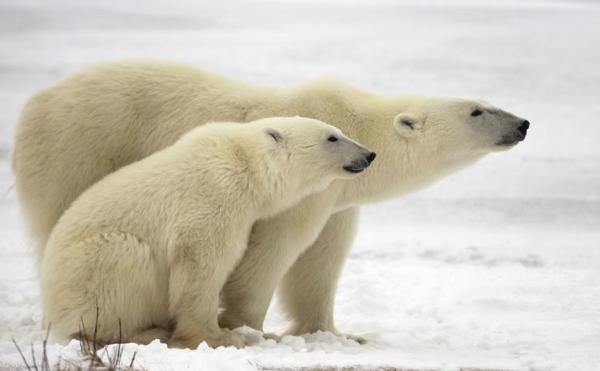
How does climate change affect a polar bear's weight?
Polar bears are currently classified as ‘vulnerable’ according to the International Union for Conservation of Nature's Red List of Threatened Species. Although hunting of this species has been significantly controlled, the current reason for their vulnerability is mainly due to climate change, something significantly affecting the Arctic sea ice which makes up much of the polar bear's natural habitat.
These bears are closely dependent on optimal ecosystem conditions. When these conditions are affected, the impact on the species is truly significant. This influencing their food sources as well as affecting the areas where they roam. They often lose weight because they cannot find enough food in their natural habitat and will venture outside of it to find sustenance.
Pollution has also been reported to be another factor affecting polar bears. Significant concentrations of chemical agents have been found in their tissues, disrupting their hormonal, immune and reproductive systems. The continued pursuit of oil exploration in the Arctic is has significant negative impacts on these animals and on the region's biodiversity more generally.
Finally, we can mention that polar bears are attracted to human-made smells and sounds. There is already evidence of fatal outcomes resulting from this approach, caused by the consumption of human-produced waste such as plastics, cans, batteries and other products.
You can discover more information about these beautiful Arctic animals with our article sharing 20 amazing facts about polar bears.

If you want to read similar articles to How Much Does a Polar Bear Weigh?, we recommend you visit our Facts about the animal kingdom category.
1. Rinker, D. C., Specian, N. K., Zhao, S., & Gibbons, J. G. (2019). Polar bear evolution is marked by rapid changes in gene copy number in response to dietary shift. Proceedings of the National Academy of Sciences of the United States of America, 116(27), 13446–13451.
https://doi.org/10.1073/pnas.1901093116
2. Rode, K. D., Robbins, C. T., Stricker, C. A., Taras, B. D., & Tollefson, T. N. (2021). Energetic and health effects of protein overconsumption constrain dietary adaptation in an apex predator. Scientific reports, 11(1), 15309.
https://doi.org/10.1038/s41598-021-94917-8
- US Fish & Wildlife Service. (2008). Polar Bear (Ursus maritimus ).
https://web.archive.org/web/20080711033807/http://www.fws.gov/endangered/factsheets/polar_bear.pdf - Wiig, Ø., Amstrup, S., Atwood, T., Laidre, K., Lunn, N., Obbard, M., Regehr, E., and Thiemann, G. (2015). Ursus maritimus . The IUCN Red List of Threatened Species.
https://dx.doi.org/10.2305/IUCN.UK.2015-4.RLTS.T22823A14871490.en

